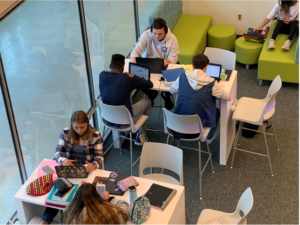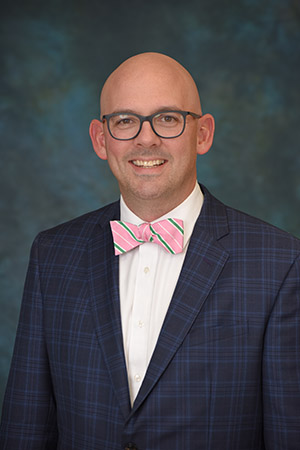What does it mean to personalize instruction for all students? Personalization seems like a daunting task, and some educators may say that it is impossible. But let’s face it—personalization is everywhere. Netflix allows each member to view movies and shows with an algorithm that adapts to their interests, doctors can now make virtual visits 24 hours a day, DoorDash will deliver food to your door within minutes, the Mirror personalizes each member’s exercise plan, and you can find transportation at your fingertips by using Uber or Lyft. The issue with education is that our world is entirely personalized, but education has stayed industrialized for more than 100 years.
Two questions have guided the evolution of personalization at Mayfield High School: How do we eliminate the barrier of time in learning? And what skills do we want our children to develop before leaving Mayfield High School that will make them successful individuals?
Our road to personalization began with a mistake. We developed a committee to analyze our current schedule and study other schedules that could maximize student learning, address mental health concerns, provide an opportunity for mentoring, and allow for intervention. This committee was formed because our student achievement data plateaued over ten years. In addition, our annual surveys of recent graduates showed that our students were prepared for their college courses, but 70 percent continued to struggle with time management and stress management. As a result, we decided to focus on our schedule. We researched schedules across the country and visited a few schools to understand their implementation. During this process, we debated for hours about the length of classes and discussed how we could incorporate everything that we deemed important within a 7.5-hour day. Then a light shined amongst our group. Was the schedule the issue, or was the type of instruction taking place in our classrooms the issue? We believed that there was a way to personalize instruction for all students in a profound, authentic way while removing the barrier of time and its impact on learning. This mistake helped transform Mayfield High School.
Staff and students also recognized that our past practices were industrialized. Teachers taught to the 28 students in their classrooms as if they all learned at the same pace. Who are we pacing for? Do we pace for our students or ourselves? Why does every student need to be assessed on the same day? Why can’t students move ahead when they are ready, while teachers provide intervention for students who are not prepared to move ahead? These were all fundamental questions that needed to be addressed.
After much reflection, collaboration, and analysis, our staff and students developed a customized instructional model that allows our students to choose a learning modality that best meets their academic and social-emotional needs. This customized model also addresses the importance of developing the soft skills critical to our students’ success beyond high school: critical thinking, problem-solving, time management, communication, collaboration, empathy, resiliency, goal setting, self-reflection, and self-advocacy. To that end, we collaboratively developed learning modalities to empower students with more voice and choice to take ownership of their learning and provide access to more personalized and authentic learning experiences. The following learning modalities were developed that every student at Mayfield High School gets to choose from when selecting their courses each year.
- Full-Day Self-Paced (“The Option”)
- Individual Self-Paced Courses
- Cross-Curricular Courses
- Traditional Courses
To help transition from a more industrialized model to a personalized model, we began by offering individual self-paced courses. An individual self-paced course provides teachers the ability to structure their classrooms in ways that allow students to move at their own pace while receiving continual support. Also, this environment provides the teacher time to offer more intensive intervention to those that need it. This is very difficult to do in a traditional classroom with a student ratio of 28:1. In a self-paced class, teachers meet with their students three days per week. During this time, they are providing direct instruction, conferencing with students, and providing choice boards.
On the days that students are not required to attend class, they can work in one of our open learning spaces. They can continue working on their current coursework or coursework from another class, giving students the opportunity to manage their time. Furthermore, if a student needs help from their current teacher, this model allows the teacher more time to work with the student in a 1:1 or small-group environment. If a student is achieving below 70 percent in the class, the student must attend class every day. Students have the opportunity to choose the number of self-paced courses in their schedule to create a hybrid combination of learning modalities that best meet their learning needs.
In addition to offering individual self-paced courses, we also offer a full-day self-paced program called The Option. Currently, The Option is a junior-senior level program that will be offered to freshmen next school year and sophomores in 2022. Within this program, students fully customize their school day without adhering to a bell schedule.
This program eliminates the barrier of time and learning by providing students with a seven-hour block of time each day to manage their academics, continue to develop their soft skills, and work on their habits of mind through mindfulness activities and self-reflection in a deep, authentic learning environment. Students do not have to go through an application process. If a student believes they will learn best in this environment, we want them to be a part of this program.
There are four core content area teachers (math, English, science, and social studies), an invention specialist, a capstone (project-based learning) teacher, a paraprofessional, a service-learning coordinator, and an internship coordinator. These staff members serve the roles of teacher, mentor, and coach.
Each day, students walk into this open learning space, where their teachers greet them and prepare for a morning meeting. During this meeting, students set their academic goals for the day while creating their daily schedule. Also, students then break up into their coaching groups with their teacher mentor and engage in a self-reflection activity. This culture-building activity creates an environment of positivity, family, and support while enforcing the importance of goal setting. After the morning meeting, students may work independently, in small groups, or in larger groups with their core teachers or peers. For example, a student can work on her math assignment for two hours, her English assignment for 30 minutes, take a break and watch 10 minutes of her favorite Netflix show, meet with her counselor to discuss college and career options, work on her college essay, work on her capstone project in our fabrication lab, and collaborate with peers on her government project. On the other hand, another student may decide to work on his research paper for the entire day. This is all about voice and choice while empowering student learning and developing soft skills.

Students in this program learn in a variety of ways. They may attend direct instruction twice per week per discipline, they may view videos created by their teachers, and some may teach their peers specific concepts. Furthermore, if students need intervention or need clarification, their teachers are in this space the entire day, ready to work 1:1 and in small groups with their students. This allows our teaching staff to serve as content-area coaches prepared to adapt when needed. Lastly, when a student feels that they are ready to be assessed on a particular unit or concept, the student chooses when to take the assessment. This reduces student stress by not overwhelming them with three or four assessments on a single day. Additionally, students have the opportunity to retake assessments for mastery. Rather than being assessed on the entire assessment again, a student will only be assessed on the concepts they have not mastered. Overall, this program is built on the foundation of agency, engagement, outcomes, and opportunity.
All students in The Option space are required to engage in a capstone project. The capstone allows students to identify a problem, conduct research, and determine a solution. Some of our students have started their own business, while others created a food pantry for community members in need. One student created a spa day for impoverished girls at one of our local elementary schools, with makeovers provided by our junior and senior cosmetology students. In addition to the capstone, students can select other full-year courses that are meaningful and relevant to them, such as internships, service learning, and work credit. This is a great way to expose students to different career paths and to bring awareness to the world around them before leaving high school.


4 Comments
Jeff, congratulations on your blog! the journey you are on is one of incredible importance and by sharing will undoubtedly help shape the thinking of many as we muster up the courage to take the risks you and your team of brilliant teachers have taken to engage students by personalizing their learning. I would urge your readers to check out the All-Access Learning website at https://www.mayfieldschools.org/AAL.aspx
Amazing!! Tears of gratitude while reading this and celebrating our partnership with a beautiful district. #mychoicmayfield
So proud of you Mr. Legan. I am blessed more than I can express to be on your team and work for you. This article sums up how your leadership and your guidance (along with your administration team) really put children first. Yay!!!!
Congrats Jeff and Mayfield. Risk-taking in education is a must to focus on the future.